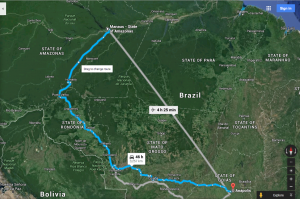 Written by admin on January 28, 2016 – 5:33 pm
Written by admin on January 28, 2016 – 5:33 pm
In December 2015, a not for profit organization located in the country of Brasil contacted Craig Thompson of CrossConnect (a division of Caldwell Global Communications) with a need. They wanted to connect two very distant locations together for a virtual sharing session. They wanted to have audio and video as a minimum. The solution needed to be able to work over a diverse array of Internet backbone links.
Caldwell Global introduced them to Zarafa WebMeetings. As a Zarafa Enterprise Hosting Partner, Caldwell staff made an account available for the customer to use for numerous testing sessions. Craig personally spent time training their staff about the rich feature set available while also discussing the optimal way to utilize this tool.
In mid-January 2016, after testing Zarafa WebMeetings side by side with other solutions including Skype, the customer chose the Zarafa WebMeetings solution. On the day of the main event, over 100 people were gathered in a facility in Anapolis, Brasil (southeast) while another group of over 100 were gathered all the way to the northwest in the Amazon region in Manaus.
Each side had a laptop with an audio OUT port used for providing audio from the other conference center. Each utilized either a built-in camera or an attachable camera to capture the video of its own location. Audio input was not optimal, as they did not have the cabling or facility to utilize a line-out from their sound board/mixer and send that into the laptop through a line in. They plan to change this for future conferences.
The conference session lasted for SIX HOURS. During that time, the meeting participants stayed connected. One local tech reported that a very small number of times the audio and video quality dropped, but it was only for a brief time. They attributed it to bandwidth spikes either at the local facilities or upstream at the carriers. During the six hour conference, participants were able to see and hear one another and enjoy a connection which could only have been made significantly better by meeting in person.
One of the unique highlights of this meeting is that in Manaus, the conference center there is located on one side of the Amazon River, and a wireless Internet link is utilized to provide the Internet access for the entire conference center. So, the conference had to traverse local wireless access points, a backhaul wireless link across the Amazon River, an Internet Service Provider link to the main exchange point in Brasil and then back down through an ISP in Anapolis, across a WAP at the local conference center and then to the laptop there.
The lead tech in Anapolis had this to say:
The meeting was long, the connection and quality were better than expected using this new tool. I think the most memorable parts of the video conference were when I took my personal laptop and connected in as a third camera and walked around before the meeting started. People on both sides were so excited to see each other. Then after the meeting while everything was still connected several people went to the front of the meeting rooms and had conversations, this was not just a one person view but a room view of people on both sides.

